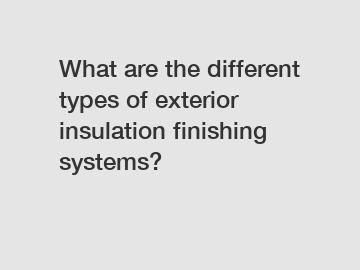What are the different types of exterior insulation finishing systems?
When it comes to protecting your home or building from the elements, exterior insulation finishing systems (EIFS) are a popular choice among many property owners. These systems provide both insulation and a finished exterior surface, creating a more energy-efficient and aesthetically pleasing building envelope. But did you know that there are different types of EIFS to choose from? In this blog post, we will explore the various types of EIFS available on the market today.
1. Traditional EIFS: Traditional EIFS consist of a layer of expanded polystyrene (EPS) foam insulation, a base coat of cement and acrylic polymers, and a finish coat of textured or smooth acrylic coating. This type of EIFS is popular for its versatility, allowing for a wide range of design options and finishes. Traditional EIFS is also known for its high insulation capabilities, reducing energy costs and improving indoor comfort levels.
2. Drainable EIFS: Drainable EIFS is a variation of traditional EIFS that includes a drainage mechanism to help prevent moisture buildup behind the system. This type of EIFS features a drainage mat or grooved foam insulation that allows water to drain away from the building, reducing the risk of water damage and mold growth. Drainable EIFS is often recommended for buildings in areas with high levels of precipitation or humidity.

3. Barrier EIFS: Barrier EIFS, also known as one-coat EIFS, is a simplified version of traditional EIFS that combines the insulation and base coat into a single layer. This type of EIFS is quicker and easier to install than traditional EIFS, making it a popular choice for projects with tight deadlines. However, barrier EIFS may not offer the same level of insulation or durability as traditional EIFS, so it is important to consider the specific needs of your building before choosing this option.
4. Hybrid EIFS: Hybrid EIFS combines the insulation properties of traditional EIFS with the durability of a stucco or stone veneer finish. This type of EIFS typically includes a thicker layer of foam insulation, a reinforced base coat, and a finish coat that replicates the look of natural stone or stucco. Hybrid EIFS is a great option for property owners looking for the energy efficiency of EIFS with the aesthetic appeal of traditional exterior finishes.
5. Exterior Insulated Stone Veneer Systems (EISVS): EISVS are a newer type of EIFS that combine the insulation benefits of EIFS with the timeless look of natural stone. These systems feature a layer of foam insulation, a reinforced base coat, and a finish coat of thin natural stone veneer. EISVS offer the same energy efficiency and versatility of traditional EIFS, but with the added beauty and durability of natural stone. This type of EIFS is a great choice for property owners looking for a high-end exterior finish that will stand the test of time.
In conclusion, there are several types of EIFS available on the market today, each with its own unique set of benefits and considerations. Whether you choose traditional EIFS for its design versatility, drainable EIFS for its moisture management capabilities, barrier EIFS for its ease of installation, hybrid EIFS for its combination of insulation and durability, or EISVS for its natural stone finish, there is an EIFS option to suit every building and budget. Consider your specific needs and goals for your building envelope, and work with a reputable EIFS contractor to determine the best type of EIFS for your project. With the right choice of EIFS, you can enjoy a more energy-efficient and attractive exterior for years to come.
Want more information on redispersible emulsion powder suppliers, aibeide, hpmc manufacturer? Feel free to contact us.

